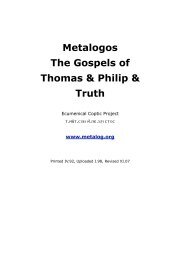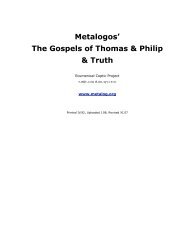Andrew Louth - Syriac Christian Church
Andrew Louth - Syriac Christian Church
Andrew Louth - Syriac Christian Church
You also want an ePaper? Increase the reach of your titles
YUMPU automatically turns print PDFs into web optimized ePapers that Google loves.
50 THE DOCTRINE OF THE PERSON OF CHRIST<br />
hypostasis, and tropos belong together. 3 In a Trinitarian context,<br />
Maximus will use these distinctions with some care. So, for instance,<br />
seeking to explain the movement in the Trinity that an expression of<br />
Gregory Nazianzen’s apparently implies, he says:<br />
For the triad is truly monad, because thus it is, and the monad<br />
truly triad because thus it subsists. Thus, there is one Godhead<br />
that is as monad, and subsists as triad. If, hearing of movement,<br />
you wonder how the Godhead that is beyond infinity is moved,<br />
understand that what happens is happening in us, and not to the<br />
Godhead. For first we are illuminated with the reason [logos] for<br />
its being, then we are enlightened about the mode in which it<br />
subsists, for we understand that something is before we<br />
understand how it is. Therefore movement in the Godhead is<br />
constituted by the knowledge about that it is and how it subsists<br />
that comes about through revelation to those who receive it.<br />
(Opusc. 1:1036C)<br />
I have italicized the key words (note, too, that Maximus also expresses<br />
the distinction of level as that between that something is and how it is).<br />
This distinction between what is natural and what is personal is an<br />
underlying theme in his metaphysics and becomes a guiding light for<br />
Maximus in his exposition of the doctrine of Christ.<br />
CHRISTOLOGY IN MAXIMUS’ EARLY WORKS<br />
Christology is central to Maximus’ ascetical theology: our ascetic<br />
struggle is, as we have seen, a response to the self-emptying of<br />
the Word in the Incarnation. The Incarnation itself is regarded by<br />
Maximus as a central turning-point in the history of the cosmos.<br />
There is a phrase from one of Gregory Nazianzen’s sermons—‘and the<br />
natures are instituted afresh, and God becomes man’ 4 —that he is fond<br />
of quoting to express this idea of the Incarnation as a turning-point,<br />
and to which he devoted one of his Ambigua (Amb. 41, which is<br />
translated below). In the early Ambigua, Maximus is mainly<br />
concerned with what is involved in the ‘instituting afresh’ of the<br />
natures: in Amb. 41 he develops an elaborate notion of the healing of<br />
the various ‘divisions’ found in everything that is. This, also, is<br />
something that properly belongs to his cosmic theology, that will be the<br />
subject of our final chapter. This is the context in which he discusses<br />
Christology: there is little technical discussion of what the union of<br />
natures in the one person of Christ involves. The same is true of Amb.<br />
10—the longest of all his Difficulties—which is the nearest thing there<br />
is to a comprehensive statement of Maximian theology.




